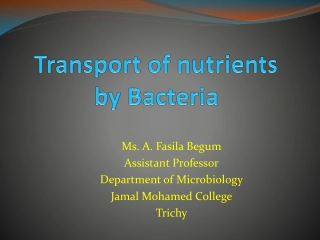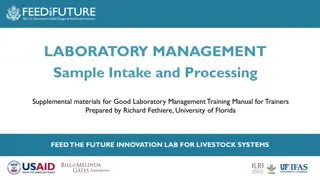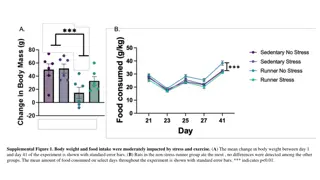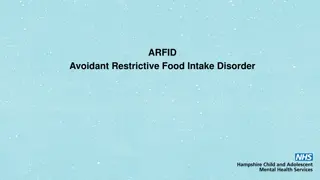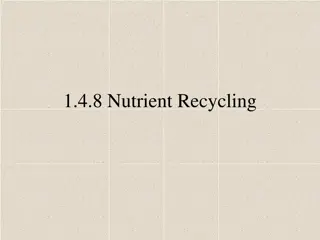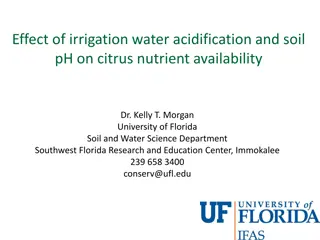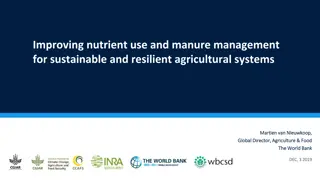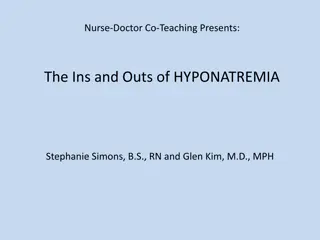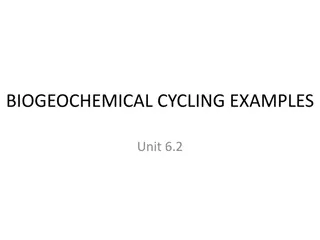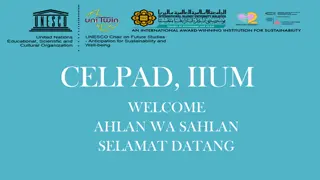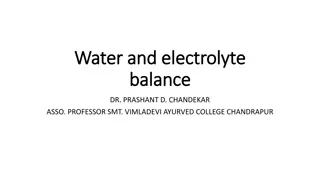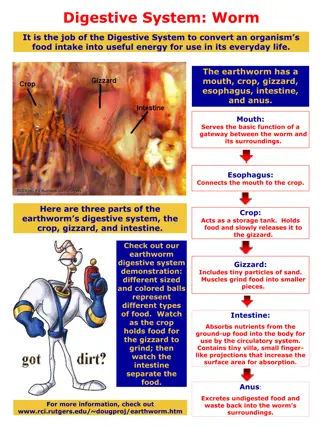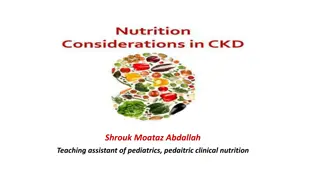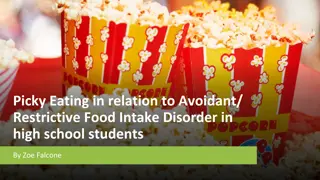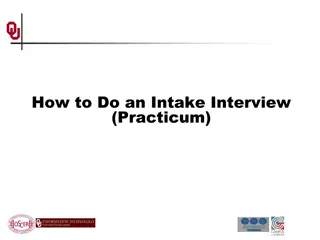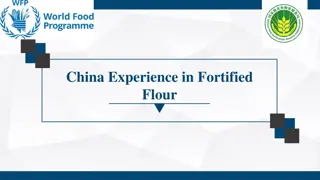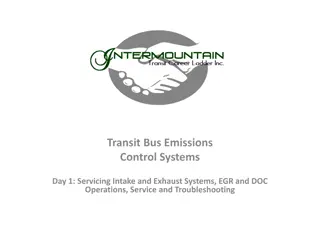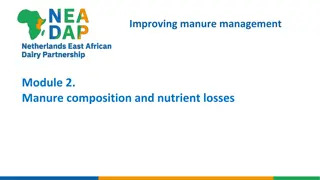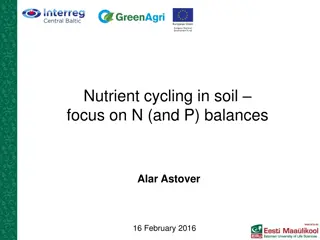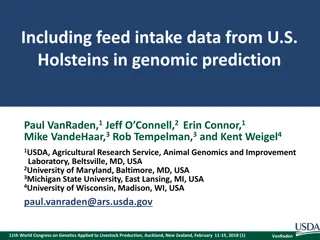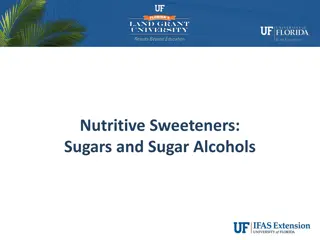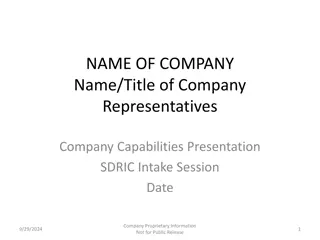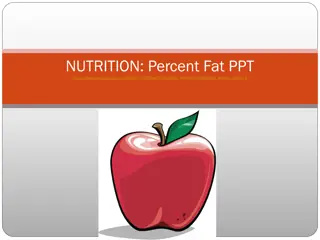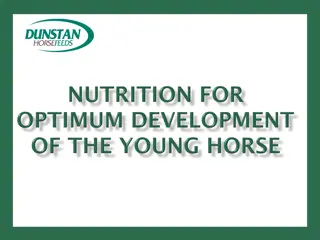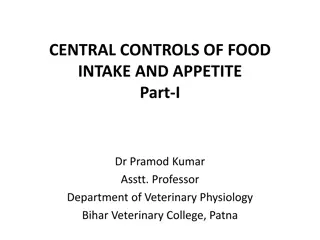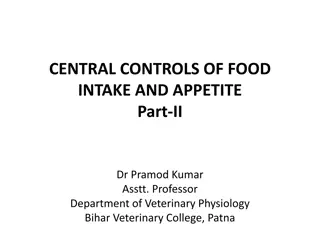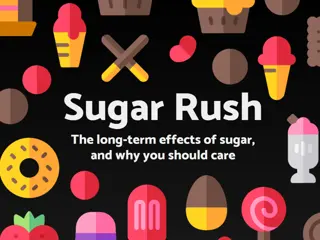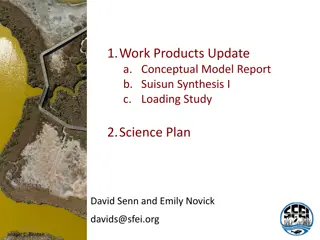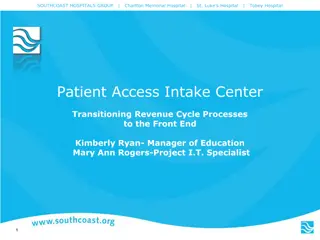Nutrient Uptake in Bacteria: Mechanisms and Factors
The process of nutrient uptake in bacteria, including the role of macronutrients, micronutrients, and environmental factors. Learn about the different mechanisms of nutrient transport and the importance of selective permeability in plasma membranes.
0 views • 25 slides
Laboratory Sample Intake and Processing Procedures
Efficiently manage sample intake and processing in your laboratory with these supplemental materials. From submission checklists to sample preparation guidelines, ensure accurate analyses by following these organized procedures. Capture essential information through submission forms, labeling standa
11 views • 15 slides
Grape Pomace Utilization in Soil Nutrient Management Study
Study on the mobility of total carbon, nitrogen, and polyphenols from grape pomace in soil columns, focusing on its relevance as an organic fertilizer rich in nutrients. The research also highlights the industrial potential of grape pomace, nutrient mobility between varieties, and methods used for c
1 views • 14 slides
Impact of Stress and Exercise on Body Weight and Food Intake in Rats
Body weight and food intake in rats were moderately influenced by stress and exercise in this experiment. The results showed differences in body weight change and food consumption among groups. Microglial metabolism and inflammatory changes were also examined, revealing consistent exercise-specific
0 views • 6 slides
Understanding ARFID: A Guide to Avoidant Restrictive Food Intake Disorder
Avoidant Restrictive Food Intake Disorder (ARFID) is a feeding and eating disorder characterized by significant weight loss, nutritional deficiency, and psychosocial impairment. Individuals may experience sensory sensitivity, lack of interest, or fear of aversive consequences. ARFID differs from pic
0 views • 18 slides
Nutrient Recycling in Ecosystems
Nutrient recycling in ecosystems involves the continuous breakdown and exchange of elements between living and non-living components, ensuring sustainability and no long-term drain on Earth's nutrients. This process includes decomposition of organic material by bacteria and fungi, uptake of nutrient
1 views • 23 slides
Understanding Citrus Nutrient Availability in Relation to Soil pH and Irrigation Water Acidification
This research by Dr. Kelly T. Morgan from the University of Florida explores the impact of soil pH, irrigation water acidification, and nutrient recommendations on citrus trees affected by HLB disease. The study examines the availability of key nutrients such as Mn and Zn, the effects of different s
0 views • 23 slides
Enhancing Nutrient Efficiency in Agriculture for Sustainable Systems
Improved nutrient use and manure management are crucial for sustainable agricultural systems. Efforts to increase nutrient efficiency through better practices can help reduce emissions and aquatic pollution. Public awareness, policy realignment, and soil data quality enhancements are key areas for p
0 views • 14 slides
Understanding Hyponatremia: Clinical Presentation and Management
Nurse-Doctor Co-Teaching presents a case study of a 63-year-old woman with hyponatremia, discussing key observations and factors relevant to her condition. The session aims to simplify the complexities of hyponatremia by reviewing the importance of correction rates, providing a framework for patient
0 views • 15 slides
Mechanisms of Nutrient Uptake by Microbial Cells
Nutrient uptake by microbial cells involves various transport mechanisms such as passive diffusion, facilitated diffusion, active transport, and group translocation. These mechanisms ensure the specific acquisition of required nutrients by the cell through the selectively permeable plasma membrane.
3 views • 15 slides
Enhancing Nutritional Security in SADC Communities through Sugar Fortification
Nutritional security is crucial for overall well-being, and this presentation explores the significant role of sugar fortification in improving micronutrient intake and combating malnutrition in SADC regions. Insights into the current status quo, strategies for enhancing micronutrient intake, and th
0 views • 15 slides
Understanding Nutrient Pollution and Its Impact on the Environment
Nutrient pollution, characterized by the excess input of nitrogen and phosphorus into water and air, is a significant environmental issue with far-reaching consequences. It can lead to toxic algae blooms, dead zones, economic losses, and adverse effects on human health. The causes of nutrient pollut
2 views • 11 slides
Important Announcement for New Intake Students - Semester 1, 2022/2023
Welcome to all new intake students of Semester 1, 2022/2023! Prepare for the English Proficiency Test (EPT), Arabic Proficiency Test (APT), and Tilawah Proficiency Test (TPT). Join the respective Telegram groups for details. No registration is required – just be present at the designated exam venu
0 views • 6 slides
European Standards for Plant Biostimulants Development
The European Committee for Standardization (CEN) plays a crucial role in developing European standards for plant biostimulants, focusing on improving plant nutrition processes independently of nutrient content. The CEN/TC.455 committee is responsible for creating standards supporting the EU Fertilis
2 views • 5 slides
Understanding Water and Electrolyte Balance in the Human Body
The body's fluid compartments, including intracellular and extracellular fluids, play a crucial role in maintaining water and electrolyte balance. This balance is regulated by movements of water and electrolytes between compartments, influenced by factors like hydrostatic and osmotic pressures. Main
2 views • 18 slides
Youth Juvenile Court Trends and Statistics in Orleans Parish
Orleans Parish Juvenile Court provides intake services and assessments for youth arrested by the New Orleans Police Department, with detailed data on intake assessments, petitioned juveniles, arrests by shifts, and top charges from June 2020 to June 2021. The charts and statistics offer insights int
0 views • 15 slides
The Digestive System of Worms: Functions and Structure
The digestive system of a worm plays a crucial role in converting its food intake into energy. It consists of various parts such as the mouth, crop, gizzard, esophagus, intestine, and anus. The mouth serves as the entry point for food intake, leading to further digestion through the other components
0 views • 9 slides
Nutrition Strategies for Children with Chronic Kidney Disease
Strict attention to nutrition is crucial for optimizing growth and survival in children with chronic kidney disease. Poor growth can arise from various factors, including poor nutritional intake and other underlying health issues. Nutrient delivery routes and considerations for energy and protein in
0 views • 37 slides
The Link Between Picky Eating and Avoidant/Restrictive Food Intake Disorder in High School Students
Picky eating behaviors in children can potentially lead to Avoidant/Restrictive Food Intake Disorder (ARFID) if not outgrown by age 6. Research indicates that parental pressure, aversive experiences, and specific eating characteristics are associated with picky eating tendencies that may predict ARF
0 views • 16 slides
Mastering the Intake Interview Process for Practicum Success
Learn the crucial steps to conduct a successful intake interview in a practicum setting. Explore goals, effective communication strategies, and specific open-ended questions to build a strong professional relationship with researchers. Dive into breakout room activities to practice modeling intake i
0 views • 6 slides
Nutrient Criteria Development Plan for High Rock Lake Summary Update
Nutrient Criteria Development in North Carolina has evolved through various stages since 2001, with the key milestones being the development of the Nutrient Criteria Implementation Plan in 2004 and the Nutrient Criteria Development Plan in 2014. The plan aims to link nutrient concentrations with the
0 views • 8 slides
Improving Nutrition Goals for Children with CF
Optimizing growth and weight gain is crucial for children with cystic fibrosis (CF) to enhance health outcomes and survival. Behavioral barriers often hinder patients from achieving nutrition goals, but interventions combining nutrition and behavioral strategies have shown effectiveness. This approa
0 views • 27 slides
Iowa Nutrient Pollution Control Measures and Strategies
Gulf Restoration Network Decision, sources of Nutrients Nitrogen (N) and Phosphorus (P), impacts of Nutrient Pollution leading to Algae Blooms and Gulf Hypoxia (Dead Zone), measures to reduce Non-Point Source (NPS) contamination, EPA's current strategy, and Iowa's approach with its Nutrient Reductio
0 views • 20 slides
Understanding Wheat Flour Fortification and Processing Technology in China
This content discusses the history, technology, and systems involved in fortified flour in China. It covers the calculation methods for nutritional efficiency of nutrients, including concepts like Dietary Reference Intakes and Recommended Nutrient Intake. Safety measures, such as Adequate Intake and
0 views • 40 slides
Transit Bus Emissions Control Systems - Day 1: Servicing and Troubleshooting
Explore the intricate components and operations of intake and exhaust systems, EGR, and DOC in transit bus emissions control systems. Learn about new technologies, common services, and troubleshooting techniques to effectively manage emissions and improve engine performance. Delve into the evolution
0 views • 57 slides
Understanding Manure Management: Compositions, Nutrient Losses, and Factors
Explore the complexities of manure management by delving into manure compositions, nutrient losses, and the various factors influencing the quality and quantity of manure. Learn about the impact of animal species, diets, and management practices on manure characteristics, as well as strategies to mi
0 views • 29 slides
Understanding Nutrient Cycling in Soil for Sustainable Agriculture
Explore the intricate processes of nutrient cycling in soil, with a focus on nitrogen (N) and phosphorus (P) balances. Discover the various inputs and outputs considered within different scales, from field to country level. Gain insights into the importance of interpreting data correctly and the imp
0 views • 22 slides
Genomic Prediction of Feed Intake in U.S. Holsteins
This study discusses the inclusion of feed intake data from U.S. Holsteins in genomic prediction, focusing on residual feed intake (RFI) as a new trait. The research involves data from research herds and genotypes of cows, with genetic evaluation models and genomic evaluation for predicting feed int
0 views • 17 slides
Understanding Nutritive Sweeteners and Added Sugars in the American Diet
Americans consume high amounts of added sugars daily, with teenagers accounting for a significant portion. Sugar intake has significantly increased over the years, leading to concerns about health implications. Various organizations recommend limiting added sugar intake to maintain overall health, e
1 views • 27 slides
Comprehensive Company Presentation for SDRIC Intake Session
Detailed company presentation covering company overview, technical capabilities, current business base, past performance, growth strategy, and business development objectives for the upcoming confidential SDRIC Intake Session on 9/29/2024.
0 views • 9 slides
Understanding Fat Intake and Nutrition Guidelines
Explore the importance of fat intake in nutrition, calculate percentage of calories from fat, learn about recommended fat intake percentages, and understand calorie content in fats, proteins, and carbohydrates. Discover how to calculate fat in foods and determine daily calorie needs based on activit
0 views • 7 slides
Nutritional Implications for Developmental Orthopaedic Diseases in Horses
Developmental Orthopaedic Diseases in horses, such as Physitis and Osteochondritis Dissecans, can be influenced by factors like trauma, genetic predisposition, and poor nutrition. Ensuring proper mineral intake, balanced nutrition, and avoiding excess caloric intake at different stages like pregnanc
0 views • 12 slides
Nutrient Watershed Permit Stakeholder Advisory Group Meeting Overview
The Nutrient Watershed Permit Stakeholder Advisory Group Meeting on December 6, 2013, discussed permit components, effluent monitoring, annual reporting, treatment optimization, nutrient studies, monitoring, reporting, support for nutrient studies, treatment plant optimization, and permit timeline.
0 views • 6 slides
Statewide BHJJ Evaluation Demographics and Trends Analysis
This report presents an evaluation of the Statewide BHJJ Program conducted by Jeff Kretschmar, Fred Butcher, and Krystel Tossone from Case Western Reserve University. It includes insights into youth demographics, enrollment numbers by county, felony trends, youth and family history, OYAS assessment
0 views • 30 slides
Understanding Central Controls of Food Intake and Appetite Regulation
Exploring the intricate mechanisms behind food intake and appetite regulation, this informative content delves into the pivotal role of the brain regions such as the hypothalamus and brainstem. It discusses how peripheral signals, neural pathways, and neuropeptides collaborate in orchestrating hunge
0 views • 13 slides
Understanding Central and Peripheral Controls of Food Intake and Appetite
This article delves into the intricate mechanisms that regulate food intake and appetite, focusing on central and peripheral factors. Neural signals, gastric distention, glucose influence, circulating lipids' role, and gut hormones all play crucial roles in shaping our eating behavior. These signals
0 views • 15 slides
Understanding Sugar Consumption: Costa Blueberry Muffin and Daily Intake Implications
A thought-provoking campaign raising awareness about sugar consumption, particularly focusing on the amount of sugar in a Costa blueberry muffin and its impact on daily intake levels. The average American consumes around 80g of sugar daily, which exceeds the recommended allowance. This excessive sug
1 views • 5 slides
Fitness Apps for Students: MyFitnessPal and ActivTrax Reviews
MyFitnessPal and ActivTrax are fitness apps designed to help users track their workouts, food intake, and reach their fitness goals. MyFitnessPal offers nutritional information and calorie intake goals, while ActivTrax provides customized workouts and instructions. These apps can be valuable tools f
0 views • 9 slides
Nutrient Conceptual Model Review Summary
Comments and feedback on a Nutrient Conceptual Model report include suggestions to address issues related to eutrophication concepts, nutrient stoichiometry, community composition, and nutrient reduction goals. Recommendations also focus on incorporating flushing/residence time discussions, predicti
0 views • 9 slides
Transformation of Patient Access Processes at Southcoast Hospitals Group
Southcoast Hospitals Group, comprising Charlton Memorial Hospital, St. Luke's Hospital, and Tobey Hospital, embarked on a significant initiative to streamline patient intake processes. This project aimed to centralize scheduling, authorization, and pre-registration, culminating in the creation of an
0 views • 16 slides
